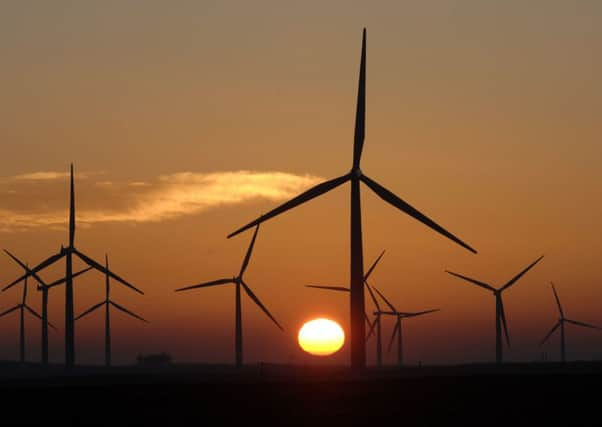Face up to wind power problems now


THE UK and the Scottish Governments are taking action to seek to reduce CO2 emissions and to reduce dependency on fossil fuel. The main strategy to achieve these goals is to substitute energy from fossil fuel with energy from renewable sources. The problem with the way that this strategy is being implemented is that the technical difficulties, the potential economic outcomes and the degree to which the goals can be achieved are not being reliably addressed.
For example, wind is being used as the main source of renewable energy for the transformation, but it cannot be relied on to deliver.
Advertisement
Hide AdAdvertisement
Hide AdIf there were ten gigawatts (GW) of installed wind capacity in Scotland, at any given time there would be only about an evens chance of having 2.5 GW or more of this capacity being generated. The most likely levels of wind generation would be less than 2.5GW. This is the opposite of what is needed. For a secure system the most likely levels of generation needs to be at the high end of the range, eg at 8GW.
If we relied only on wind power, we would have to expect the lights not to go on when you flicked the switch. If this were the case we would not be able to support an industrial society. The only feasible technical solution to this problem is to maintain a fleet of thermal generators (coal, gas, nuclear) that, along with hydro, can provide a reliable output. Wind capacity in the system has to be effectively mirrored by thermal capacity. It is obvious that this pushes up the cost of electricity. Even without this extra “integration cost”, the cost of wind energy is higher than from other sources. If it were not, it would not need to be subsidised. Extra transmission costs also need to be taken into account. The cost of wind energy cannot go down as the amount in the system increases. It can only go up.
The negative effect of renewable energy on the risk that supply will not meet demand has to be considered on a system basis. Reliable technology exists that can be used to keep this risk at an acceptable level. But in order to do this, a central authority is needed to do the calculations and take action to ensure that the necessary generation capacity is made available. Market forces cannot be relied on to deliver a secure supply of electricity. A response to this is: “The problems we have are due to government intervention in the market. Is central authority not the problem rather than the solution?”
Some people believe that an enterprise that operates in the market will always be more successful than one run by a government. Reality is not as simple as that. Markets work much to the advantage of customers – or not. For example, the privatisation of air travel in the 1980s has resulted in a market that allows a wide choice of routes and fares making flying much more affordable.
On the other hand competition among banks has not served the nation well in recent years. Government bodies can be highly successful – or not.
For example, Scottish Water is a government body that performs very successfully in comparison with private water companies. But the nationalisation of shipbuilding in 1977 was a disaster.
What makes the difference between a successful and an unsuccessful government organisation? Crucial factors are (a) the competence of those who manage the enterprise and (b) the degree to which politicians allow them to get on with their business. Government enterprises tend to become less successful when politicians make decisions to satisfy demands of a sector of the electorate in order to gain votes.
That they do take action on what voters want is entirely appropriate but what some voters want may not be in the best interests of the populace. For electricity generation we have very good evidence that a central authority is both essential and can work well. The 1926 UK Electricity Act created a competent national body the actions of which very successfully modernised the electricity system that was a combination of private and municipal ownership. The North American Electric Reliability Corporation imposes strict standards for security of supply over the whole of the US and Canada. The need for this body was prompted by serious failures in supply.
Advertisement
Hide AdAdvertisement
Hide AdTwo options are: Wait until blackouts show the system is not fit for purpose, then set up a commission to investigate the reasons for the failures and struggle to prevent further lapses or: Set up a commission to fix it now and avoid the problems. Which option would you choose?
• Professor Iain A MacLeod represents Scientific Alliance Scotland www.scientific-alliance.org/scotland